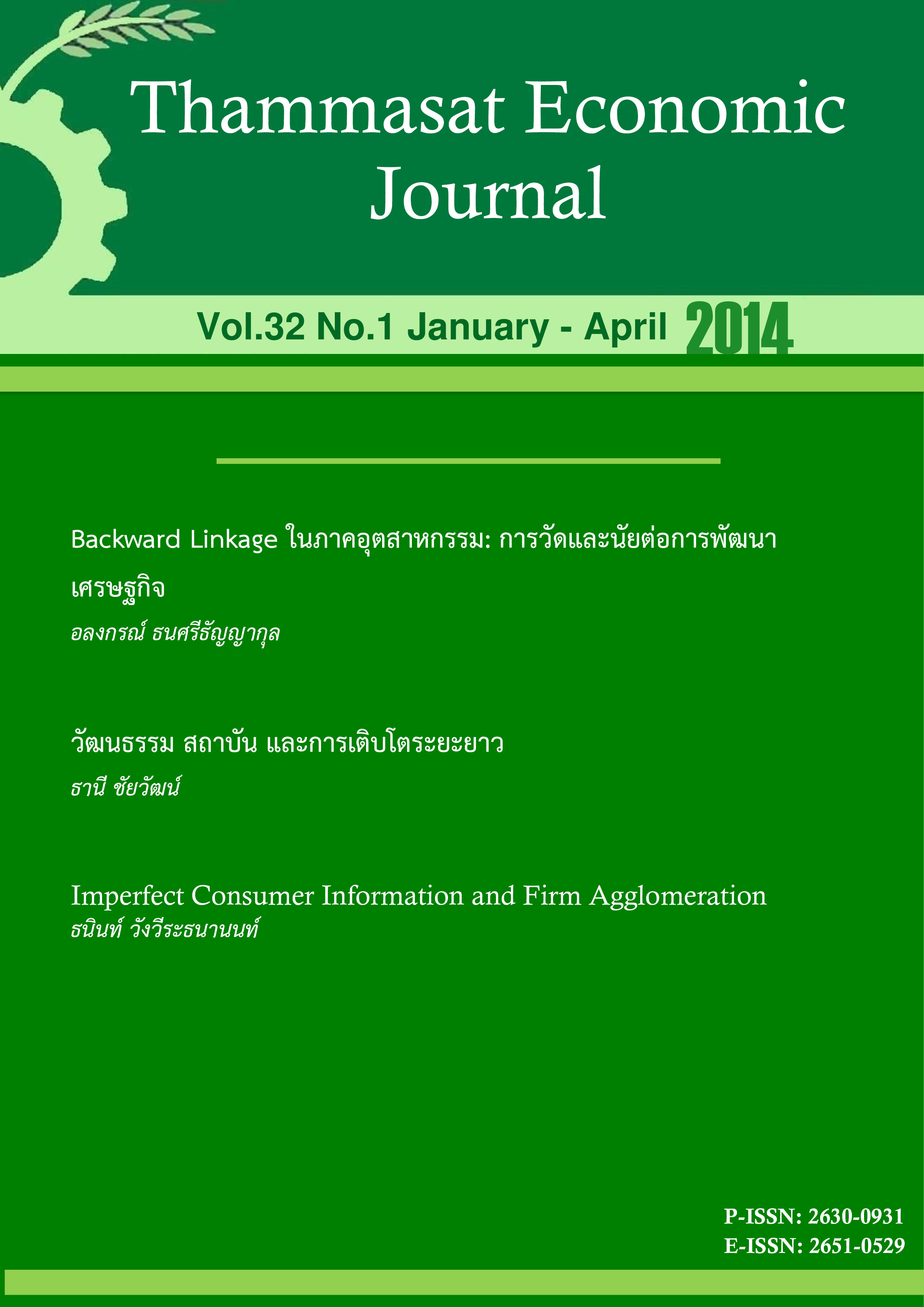Culture, Institutions and Long-run Growth
Abstract
This paper consists of two parts. First, it reviews literature on fundamental causes of growth, which are geography, culture and institutions. They can affect long-run growth through collective action. Second, it has done empirically to the case of Thailand. Result on macro aspect points out the relationship between trust (culture), quality of institutions, and long-run growth is not coincide with literature. Local trust does not have significant impact on supervision of institution which limits long-run growth. So escape of middle income trap should consider the importance of culture.
References
2.Acemoglu, Daron (2009). Introduction to Modern Economic Growth. New York: Princeton University Press.
3.Acemoglu, Daron, Simon Johnson and James A. Robinson. (2002). Reversal Of Fortune: Geography And Institutions In The Making Of The Modern World Income Distribution, The Quarterly Journal of Economics, 117(4), pp. 1231-1294, November.
4.Acemoglu, Daron, Simon Johnson and James A. Robinson. (2005). Institutions as a Fundamental Cause of Long-Run Growth, Handbook of Economic Growth1A: pp.386-472.
5.Alesina, Alberto and Paola Giuliano. (2010). The Power of the Family, Journal of Economic Growth, Springer, 15(2), pp. 93-125.
6.Alland, Alexander. (1970) . Adaptation in Cultural Evolution: An Approach to Medical Anthropology. New York: Columbia University Press.
7.Almond, Gabriel A. and Sidney Verba. (1963). The Civic Culture: Political Attitudes and Democracy in Five Nations. SAGE Publications.
8.Banfield, Edward C. (1958). Moral Basis of a Backward Society. New York : The Free Press.
9.Berggen, Niclas and Christian Bjornskov. (2013). Does Religiosity Promote Property Rights and the Rule of Law?,Journal of Institutional Economics9:02, pp. 161-185.
10.Bowles, Samuel and Herbert Gintis. (2013). A Cooperative Species: Human Reciprocity and Its Evolution. NJ: Princeton University Press.
11.Brahmajothi V, Pitchappan RM, Kakkanaiah VN, Sashidhar M, Rajaram K, Ramu S, Palanimurugan K, Paramasivan CN, and Prabhakar R. (1991). Association of Pulmonary Tuberculosis and HLA in South India, Tubercle 72(2): pp. 123-132.
12.Djankov, Simeon, Edward Glaeser, Rafael La Porta, and Florencio Lopez-de-Silanes and Andrei Shleifer. (2003). The New Compartive Economics,Journal of Comparative Economics, 31:pp. 653-675.
13.Esposito, Elena. (2012). Exposure to Diseases, Caste Systems and Technology in Pre-Modern Societies Unpublished Manuscript, Presented at 27thAnnual Congressofthe European Economic Association and 67thEuropean Meetingofthe Econometric Society.
14.Fukuyama, Fracis. (1995). Trust: the Social Virtues and the Creation of Prosperity. New York : The Free Press.
15.Gallup, John Luke, Jeffrey D. Sachs, and Andrew D. Mellinger.(1999). Geography and Economic Development,International Regional Science Review, 22(2) (August 1999): pp. 179-232.
16.Gill, Anthony and Erik Lundsgaarde. (2004). State Welfare Spending and Religiosity: A Cross-National Analysis, Unpublished Manuscript, University of Washington, January.
17.Glaeser, Edward, Rafael La Porta, Florencio Lopez-de-Silane and Andrei Shleifer. (2004). Do Institutions Cause Growth?, NBER Working Papers 10568, National Bureau of Economic Research.
18.Greif, Avner. (1994). "Cultural Beliefs and the Organization of Society: A Histroical and Theoretical Reflection on Collectivist and Individualist Societies, Journal of Political Economy,5 (October) 102: pp. 912-50.
19.Guiso Luigi, Paola Sapienza and Luigi Zingales. (2006). Does Culture Affect Economic Outcomes?, Journal of Economic Perspectives, Spring.
20.Guiso Luigi, Paola Sapienza and Luigi Zingales. (2008). The Role of Social Capital in Financial Development, The American Economic Review, 94(3) (Jun., 2004), pp. 526-556.
21.Henderson, J. Vernon, Adam Storeygard, and David N. Weil. (2012). Measuring Economic Growth from Outer Space. American Economic Review, 102(2): pp. 994-1028.
22.Inglehart, Ronald. (1988). The Renaissance of Political Culture, The American Political Science Review, 82(4) (Dec., 1988), pp. 1203-1230.
23.Inglehart, Ronald. (1997). Modernization and Postmodernization: Cultural, Economic, and Political Change in 43 Societies. NJ: Princeton University Press.
24.Knack, Stephen and Phillip Keefer. (1997). Does Social Capital Have an Economic Impact? A Cross-country Investigation, Quarterly Journal of Economics, 112 (4), pp. 1252–88.
25.La Porta, Rafael, Florencio Lopez de Silanes, Andrei Shleifer, and Robert Vishny. (1998). Law and Finance, Journal of Political Economy, pp. 1131-1150.
26.McArthur John W., and Jeffrey Sachs. (2001). Institutions and Geography: Comment on Acemoglu, Johnson and Robinson (2000), NBER Working Paper No. 8114. National Bureau of Economic Research.
27.McCleary, Rachel M. and Robert J. Barro. (2006). Religion and Economy, Journal of Economic Perspectives, 20(2) Spring 2006: pp. 49–72.
28.McNeill, William H., [1976] (1998). Plagues and Peoples. New York: Anchor Press.
29.Montesquieu, Charles de Secondat, [1748] (1989). The Spirit of Laws. New York: Cambridge University Press.
30.Myerson, Roger.(1991). Game Theory: Analysis of Conflict. Cambridge: Harvard University Press.
31.Myrdal, Gunnar. (1968). Asian Drama: An Inquiry into the Poverty of Nations, Volume 3, New York: Twentieth Century Fund.
32.Nannicini, Tommaso, Andrea Stella, Guido Tabellini and Ugo Troiano. (2010). Social Capital and Political Accountability, (December 1, 2010). FEEM Working Paper No. 58.
33.Negroni, Giorgio. (2012). The Anthropology of Food Acquisition and Sharing, Lecture Note of Social Norms in an Evolutionary Perspective Class, University of Bologna.
34.North, Douglass C.(1981). Structure and Change in Economic History. New York: Norton Press.
35.North, Douglass C.(1990). Institutions, Institutional Change, and Economic Performance. New York: Cambridge University Press.
36.North, Douglass C. (1991). Institutions, Journal of Economic Perspectives, 5(1) Winter, pp. 97–112.
37.Sachs, Jeffrey D. (2001). Tropical Underdevelopment, NBER Working Paper No. 8119. National Bureau of Economic Research.
38.Sachs, Jeffrey. (2012). Government, Geography, and Growth: The True Drivers of Economic Development, Foreign Affairs, 91(5) September/October.
39.Scheve, Kenneth and David Stasavage. (2005). Religion and Preferences for Social Insurance, Quarterly Journal of Political Science, 2006, 1: pp. 255–286.
40.Schotter, Andrew. (1981). The Economic Theory of Social Institutions. New York: Cambridge University Press.
41.Siddiqui MR, Meisner S, Tosh K, Balakrishnan K, Ghei S, Fisher SE, Golding M, Shanker Narayan NP, Sitaraman T, Sengupta U, Pitchappan R, and Hill AV. (2001). A Major Susceptibility Locus for Leprosy in India Maps to Chromosome 10 p 13,Nature genetics27(4): pp. 439-441.
42.Stelios Michalopoulos. (2012). The Origins of Ethnolinguistic Diversity, American Economic Review, American Economic Association, vol. 102(4), pp. 1508-39, June.
43.Tabellini, Guido. (2007). Culture and Institutions, CEPR Discussion Papers 6589, C.E.P.R. Discussion Papers.
44.Tabellini, Guido. (2010). Culture and Institutions: Economic Development in the Regions of Europe, Journal of the European Economic Association, European Economic Association, 8(4), pp. 677-716.










